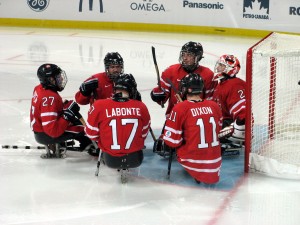カナダã®è‹±èªžã‚’話ã™: ãり対. ãã‚Š
 昨日, when I attended the Canada-Sweden sledge hockey game during the ãƒãƒ³ã‚¯ãƒ¼ãƒãƒ¼ 2010 パラリンピック, I got to wondering about the word “ãã‚Š.”
昨日, when I attended the Canada-Sweden sledge hockey game during the ãƒãƒ³ã‚¯ãƒ¼ãƒãƒ¼ 2010 パラリンピック, I got to wondering about the word “ãã‚Š.”
米国ã§ã¯, we had a ãã‚Š, but until I came to Canada, I wasn’t familiar with the term “sledge.”
ãã‚Œã¯ç±³ã¨åˆ¤æ˜Ž. stands alone on the sled question, ホッケーã¯æ‡¸å¿µã—ã¦ã„ã‚‹å°‘ãªãã¨ã‚‚ã“ã“ã§.
パラリンピックã®ã‚¹ãƒãƒ¼ãƒ„ã¨å‘¼ã°ã‚ŒãªãŒã‚‰ã€ “sled hockey” in the United States, it’s known as スレッジホッケー in the rest of the world.
1960年代ã«ã‚¹ã‚¦ã‚§ãƒ¼ãƒ‡ãƒ³ã§ç™ºæ˜Žã•ã‚Œ, アイススレッジホッケーã¯ãƒ‘ラリンピックã§ãã®ãƒ‡ãƒ“ューを果ãŸã—㟠1994 リレãƒãƒ³ãƒ¡ãƒ«å†¬å£ã‚ªãƒªãƒ³ãƒ”ック.
Sledge hockey players sit on sledges (ã¾ãŸã¯ãã‚Š) with two blades and hold double-ended sticks in each hand. They use the sharp end of the stick to propel themselves across the ice, while the curved edge — resembling a traditional hockey stick — is used for passing and shooting the puck.
ã¨ã“ã‚ã§, スウェーデン人ã¯ã‚²ãƒ¼ãƒ を発明ã—ãŸã‹ã‚‚ã—ã‚Œãªã„ãŒ, yesterday Canada won, 10-1.
ã™ã¹ã¦ã® パラリンピックアイススレッジホッケーニュース, ã”覧ãã ã•ã„ Vancouver2010.com.
ã¨ã®è©³ç´°ã¯ speaking Canadian English, ç§ãŸã¡ã‚’å‚ç…§ã—ã¦ãã ã•ã„。 “カナダã¨ã„ãˆã°” 投稿 ã“ã“ã§, ã“ã“ã§, 㨠ã“ã“ã§.
写真©アランアルãƒãƒ¼ãƒˆ




















